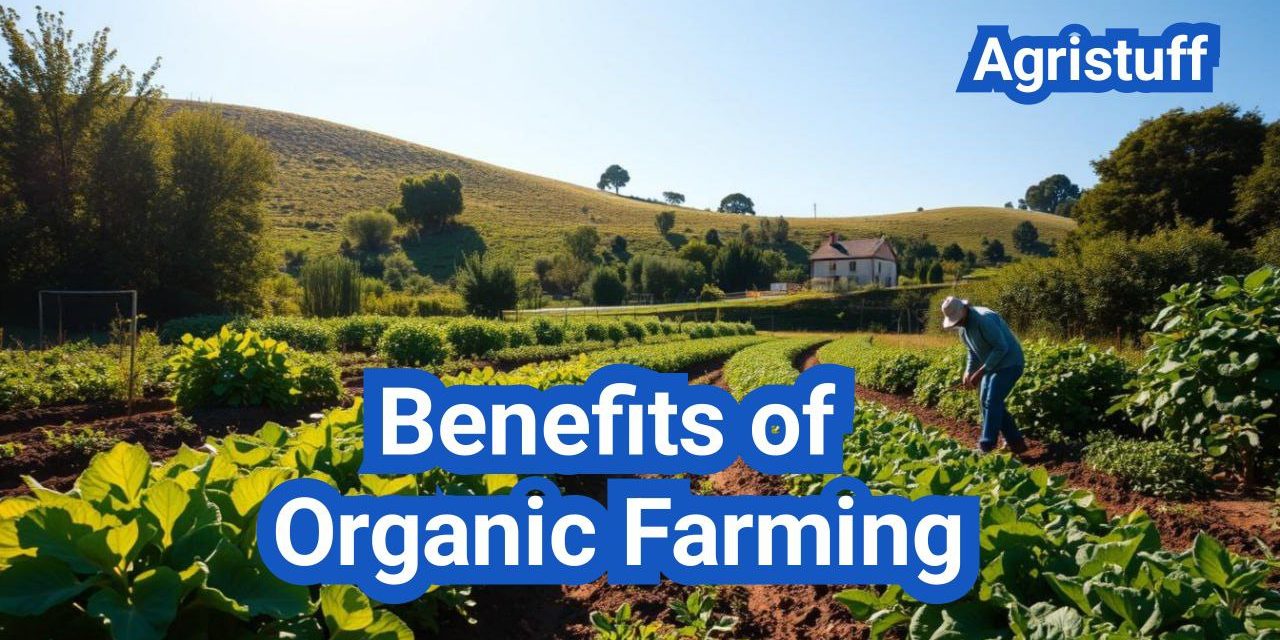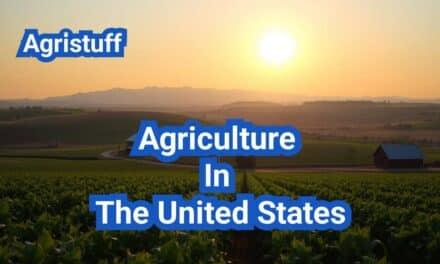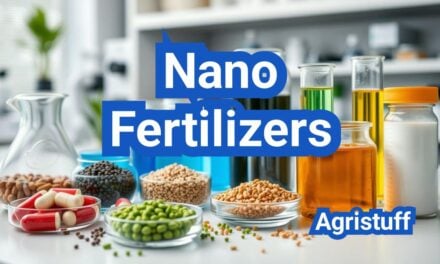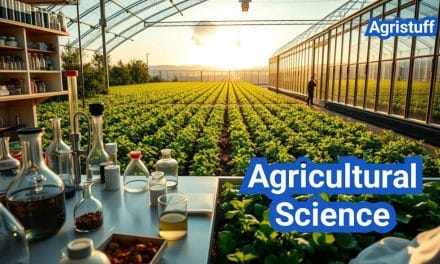Organic farming is revolutionizing the way we produce and consume food, combining environmental stewardship with innovative practices.
This method of agricultural production focuses on sustainability, ensuring that farming practices are environmentally friendly and responsible. By adopting sustainable agriculture techniques, farmers can improve soil health, conserve water, and reduce the use of harmful chemicals.
The importance of organic farming benefits cannot be overstated, as they contribute to a healthier ecosystem and support biodiversity. As consumers become more aware of the impact of their food choices, the demand for organically produced goods continues to grow.
Key Takeaways
- Organic farming promotes environmental sustainability.
- Sustainable agriculture techniques improve soil health and conserve water.
- Organic farming reduces the use of harmful chemicals.
- It supports biodiversity and a healthier ecosystem.
- Growing demand for organic products reflects consumer awareness.
What Makes Farming “Organic”?
At its core, organic farming is about adopting practices that promote ecological harmony. Organic farming is based on ecological processes, biodiversity, and cycles adapted to local conditions, rather than on the use of inputs with harmful effects.
Core Principles and Practices
Organic farming adheres to several core principles, including maintaining soil health through natural methods, enhancing biodiversity, and using local resources efficiently. Practices include crop rotation, composting, and biological pest control. These methods ensure that farming is sustainable and environmentally friendly.
The use of natural amendments and locally adapted crop varieties further supports the ecological balance. By avoiding synthetic fertilizers and pesticides, organic farming promotes a healthier ecosystem.
Differences from Conventional Agriculture
Unlike conventional agriculture, which often relies on chemical inputs to boost yields, organic farming focuses on long-term sustainability. Organic farming methods improve soil health, reduce pollution, and promote biodiversity. This approach not only benefits the environment but also results in produce that is free from harmful chemicals.
By choosing organic farming, farmers can contribute to a more sustainable food system. The differences between organic and conventional farming are significant, with organic farming offering a more environmentally friendly alternative.
The Benefits of Organic Farming for Environmental Health

By adopting organic farming methods, we can mitigate some of the most pressing environmental issues. Organic farming is a holistic production management system that promotes and enhances ecosystem health. This approach to farming is particularly beneficial for environmental health, as it avoids the use of synthetic fertilizers and pesticides, which can pollute waterways and harm wildlife.
Reducing Chemical Runoff and Water Pollution
One of the significant environmental benefits of organic farming is the reduction in chemical runoff and water pollution. Unlike conventional farming, which relies heavily on synthetic fertilizers and pesticides, organic farming uses natural methods to control pests and diseases. This approach significantly reduces the amount of chemical pollutants that enter water bodies, thereby protecting aquatic life and improving water quality.
Promoting Biodiversity and Wildlife Habitats
Organic farming also plays a crucial role in promoting biodiversity and maintaining healthy wildlife habitats. By using crop rotation, compost, and other natural farming practices, organic farms create diverse ecosystems that support a wide range of plant and animal species. This biodiversity is essential for maintaining ecological balance and ensuring the long-term sustainability of farming systems.
Carbon Sequestration and Climate Change Mitigation
Furthermore, organic farming contributes to carbon sequestration and helps mitigate climate change. Organic farming practices like incorporating cover crops, using compost, and minimizing tillage enhance soil’s carbon storage capacity. By sequestering more carbon in the soil, organic farming can help reduce atmospheric CO2 levels, thereby playing a role in combating global warming.
How Organic Practices Improve Soil Health
Organic farming’s focus on soil health is what sets it apart from conventional farming methods. By adopting practices that enhance soil organic matter, improve microbial activity, and prevent erosion, organic farming contributes to a more sustainable agricultural system.
Building Soil Organic Matter Step-by-Step
Building soil organic matter is a critical step in improving soil health. This can be achieved through the incorporation of cover crops, addition of compost, and reduction of tillage. Cover crops help to add organic matter, reduce soil erosion, and provide nutrients. Compost adds vital nutrients and improves soil structure. By minimizing tillage, soil disturbance is reduced, preserving soil organic matter.
Enhancing Microbial Activity and Soil Structure
Microbial activity is essential for a healthy soil ecosystem. Organic practices such as adding organic amendments and using cover crops enhance microbial activity. This, in turn, improves soil structure, allowing for better water infiltration and aeration. A well-structured soil supports healthy root growth and increases crop productivity.
Preventing Erosion Through Sustainable Methods
Soil erosion is a significant threat to soil health. Organic farming practices such as contour farming, terracing, and cover cropping help prevent erosion. These methods reduce soil loss, retain soil moisture, and promote soil health. By adopting these sustainable practices, farmers can protect their soil for future generations.
Health Benefits of Organic Produce

There is growing evidence that organic produce can provide numerous health benefits, making it a worthwhile choice for consumers looking to improve their diet and overall wellbeing.
One of the primary advantages of organic produce is its potential to reduce exposure to synthetic pesticides. Conventional farming often relies on chemical pesticides, which can leave residues on fruits and vegetables. These residues have been linked to various health issues, including neurological problems and certain cancers. In contrast, organic farming practices prohibit the use of synthetic pesticides, resulting in lower residue levels on organic produce.
Reduced Exposure to Synthetic Pesticides
Studies have shown that individuals who consume organic produce have lower levels of pesticide residues in their bodies. For example, a study published in the Journal of Exposure Science & Environmental Epidemiology found that children who ate organic produce had significantly lower levels of organophosphate pesticides in their urine compared to those who consumed conventional produce.
Nutritional Quality Comparisons
Research into the nutritional differences between organic and conventional produce has yielded mixed results. However, some studies suggest that organic produce may have higher levels of certain nutrients, such as antioxidants and vitamins. A meta-analysis published in the British Journal of Nutrition found that organic crops had higher levels of antioxidants and lower levels of cadmium, a toxic metal, compared to conventional crops.
Addressing Antibiotic Resistance Concerns
The use of antibiotics in conventional livestock farming has contributed to the growing problem of antibiotic resistance. Organic farming practices, on the other hand, prohibit the use of antibiotics for growth promotion, reducing the risk of antibiotic-resistant bacteria. By choosing organic meat and dairy products, consumers can help mitigate this public health concern.
In conclusion, the health benefits of organic produce are multifaceted, ranging from reduced exposure to synthetic pesticides to potential improvements in nutritional quality and contributions to addressing antibiotic resistance. As consumers become more aware of these benefits, the demand for organic produce is likely to continue growing.
Economic Benefits of Organic Farming
Organic farming offers numerous economic benefits that can enhance farm profitability. By adopting organic practices, farmers can tap into premium markets, reduce their input costs, and build long-term sustainability.
Capturing Premium Market Prices
One of the significant economic benefits of organic farming is the ability to capture premium market prices. Organic produce is in high demand, and consumers are often willing to pay more for products that are certified organic. This premium pricing can significantly boost a farm’s revenue.
Reducing Input Costs Over Time
Organic farming methods can also help reduce input costs over time. By using natural fertilizers and pest control methods, farmers can decrease their reliance on expensive synthetic chemicals. Additionally, practices like crop rotation and composting can improve soil health, reducing the need for external inputs.
Building Long-term Farm Profitability
Building long-term farm profitability is another key economic benefit of organic farming. By focusing on sustainable practices, farmers can improve their soil’s fertility, biodiversity, and overall health, leading to more resilient and productive farms. This long-term approach can ensure that the farm remains profitable for years to come.
| Economic Benefit | Description | Impact |
|---|---|---|
| Premium Market Prices | Higher prices for organic produce | Increased Revenue |
| Reduced Input Costs | Lower costs for fertilizers and pest control | Improved Profit Margins |
| Long-term Profitability | Sustainable practices for long-term success | Resilient and Productive Farms |
How to Transition to Organic Farming: A Step-by-Step Guide

To successfully transition to organic farming, farmers must follow a systematic approach that involves assessing their land and resources, creating a comprehensive transition plan, and understanding the certification requirements.
Assessing Your Land and Resources
The first step in transitioning to organic farming is to assess your land and resources thoroughly. This involves evaluating the soil quality, existing biodiversity, and available infrastructure.
Soil Testing and Analysis
Soil testing is crucial to determine the nutrient content, pH levels, and presence of any contaminants. This analysis will help in creating a tailored plan for improving soil health.
Identifying Natural Resources and Limitations
Identifying the natural resources available on your farm, such as water sources and existing ecosystems, is vital. Additionally, understanding the limitations, such as soil constraints or climate challenges, will help in devising strategies to overcome them.
| Assessment Criteria | Description | Importance |
|---|---|---|
| Soil Quality | Evaluation of nutrient content and pH levels | High |
| Biodiversity | Assessment of existing ecosystems and wildlife | High |
| Infrastructure | Evaluation of available farm infrastructure | Medium |
Creating a 3-Year Transition Plan
A 3-year transition plan is essential for a successful shift to organic farming. This plan should outline the steps to be taken each year to improve soil health, manage pests and diseases, and enhance biodiversity.
“A well-planned transition is key to reaping the benefits of organic farming. It requires patience, dedication, and a clear understanding of the processes involved.” –
USDA Organic Farming Expert
Understanding Certification Requirements
To become certified organic, farmers must comply with the regulations set by the certifying agency, which typically involves maintaining detailed records of farming practices, undergoing inspections, and ensuring that all practices meet organic standards.
By following these steps and maintaining a commitment to organic principles, farmers can successfully transition to organic farming and enjoy the benefits of improved soil health, biodiversity, and market opportunities.
Essential Organic Soil Management Techniques

Soil health is critical in organic farming, and there are several key techniques to manage it effectively. Organic soil management involves practices that enhance soil fertility, structure, and biodiversity. These practices not only improve soil health but also contribute to a more sustainable farming system.
Implementing Effective Cover Cropping
Cover cropping is a vital technique in organic soil management. It involves planting crops between crop cycles to protect and enhance the soil. Cover crops help reduce erosion, improve soil structure, and increase nutrient availability. Leguminous cover crops, such as clover and beans, also fix atmospheric nitrogen, reducing the need for external nitrogen inputs.
Building and Applying Compost
Composting is another essential practice for maintaining soil health. It involves decomposing organic materials to create a nutrient-rich soil amendment. Compost improves soil structure, enhances microbial activity, and provides essential nutrients for plant growth.
Hot Composting Methods
Hot composting is a rapid decomposition process that involves maintaining high temperatures (typically between 130°F and 140°F) to kill pathogens and weed seeds. This method requires regular turning of the compost pile to ensure adequate aeration.
Vermicomposting for Smaller Operations
Vermicomposting, or worm composting, is a suitable method for smaller organic farms. It involves using earthworms to break down organic waste into a high-quality compost. Vermicomposting produces a nutrient-rich compost that is ideal for improving soil fertility.
Designing Crop Rotation Systems
Crop rotation is a systematic approach to deciding which crops to grow on a particular piece of land over time. It helps maintain soil fertility, reduce pest and disease pressure, and improve crop yields. A well-designed crop rotation plan can significantly enhance the overall health and productivity of the soil.
| Crop Rotation Benefits | Description |
|---|---|
| Soil Fertility Improvement | Crop rotation enhances soil fertility by alternating between crops with different nutrient requirements. |
| Pest and Disease Management | Rotating crops helps break the life cycle of pests and diseases, reducing the need for chemical interventions. |
| Increased Crop Yields | A well-planned crop rotation can lead to improved crop yields due to better soil health and structure. |
Natural Pest Management Strategies for Organic Farms

Natural pest management strategies are essential for maintaining the integrity of organic farms. These methods not only help in controlling pests but also contribute to a balanced ecosystem.
Attracting and Supporting Beneficial Insects
One of the most effective natural pest management strategies is attracting and supporting beneficial insects. Beneficial insects, such as ladybugs and lacewings, prey on pests that can damage crops. To attract these beneficial insects, farmers can plant a variety of flowers that provide nectar and pollen, such as marigolds and dill.
- Plant diverse flowers to attract beneficial insects.
- Maintain ecological balance by avoiding broad-spectrum pesticides.
- Create insect-friendly habitats around the farm.
Installing Physical Barriers and Traps
Physical barriers and traps are another crucial component of natural pest management. Row covers, for example, can prevent insects from reaching crops. Sticky traps can capture flying pests, reducing their population.
- Use row covers to protect crops from flying insects.
- Install sticky traps to capture and monitor pest populations.
- Employ copper tape to deter slugs and snails.
Preparing Plant-Based Pest Deterrents
Plant-based pest deterrents offer a sustainable way to manage pests. For instance, neem oil and garlic sprays can be used to repel or kill pests. These deterrents are not only effective but also environmentally friendly.
Key plant-based deterrents include:
- Neem oil
- Garlic spray
- Hot pepper spray
Effective Organic Weed Control Methods

Weed management is a critical component of organic farming, requiring innovative and sustainable approaches. Effective weed control is crucial for maintaining soil health, reducing competition for water and nutrients, and promoting healthy crop growth.
Strategic Mulching Techniques
Mulching is a highly effective method for controlling weeds in organic farming. By applying a layer of organic material such as straw, wood chips, or leaves, farmers can suppress weed growth by blocking light and preventing seed germination. Strategic mulching involves choosing the right type of mulch and applying it at the optimal thickness to maximize its weed-suppressing effects.
Mechanical Cultivation Tools and Timing
Mechanical cultivation is another key strategy for controlling weeds in organic systems. This involves using tools such as cultivators, hoeing, and flaming to disrupt weed growth. The timing of mechanical cultivation is critical, as it is most effective when weeds are at a young stage of growth. Regular cultivation can help control weeds and improve soil aeration.
Alternative Weed Management Approaches
In addition to mulching and mechanical cultivation, there are several alternative approaches to weed management in organic farming. These include using cover crops that outcompete weeds, applying natural herbicides derived from plants, and employing solarization techniques to kill weeds through heat. By combining these methods, farmers can develop a comprehensive weed management strategy that is both effective and sustainable.
Water Conservation in Organic Farming Systems
Effective water conservation strategies are essential for the success and sustainability of organic farming practices. Organic farming places a significant emphasis on conserving water, not just as a resource, but as a principle that underpins the entire farming philosophy.
Implementing Efficient Irrigation Methods
Efficient irrigation is crucial for minimizing water waste in organic farming. Techniques such as drip irrigation and sprinkler systems can significantly reduce water usage. Drip irrigation, for instance, delivers water directly to the roots of plants, reducing evaporation and runoff.
The use of soil moisture sensors can also optimize irrigation by ensuring that water is applied only when necessary. This not only conserves water but also reduces the energy required for pumping.
Setting Up Rainwater Harvesting Systems
Rainwater harvesting is another effective strategy for conserving water in organic farming. By collecting and storing rainwater, farmers can reduce their reliance on groundwater and surface water sources. This can be particularly beneficial during periods of drought or water scarcity.
Rainwater harvesting systems can range from simple roof catchment systems to more complex storage tanks. The collected rainwater can be used for irrigation, livestock, and even domestic purposes.
Adopting Drought-Resistant Farming Techniques
Drought-resistant farming techniques involve selecting crop varieties that are more resilient to water stress. This can include using cover crops that help retain soil moisture and reduce erosion. Mulching is another technique that can help conserve soil moisture and suppress weeds.
By adopting these techniques, organic farmers can not only conserve water but also improve the overall resilience of their farming systems.
| Water Conservation Method | Description | Benefits |
|---|---|---|
| Efficient Irrigation | Using drip irrigation and soil moisture sensors | Reduces water waste, lowers energy costs |
| Rainwater Harvesting | Collecting and storing rainwater | Reduces reliance on groundwater, beneficial during droughts |
| Drought-Resistant Techniques | Using resilient crop varieties and mulching | Improves soil moisture retention, reduces erosion |
Marketing Your Organic Products Successfully

Successfully marketing your organic products requires a strategic approach to reach your target audience. In today’s competitive organic market, farmers need to adopt effective marketing strategies to stand out and attract consumers.
Building Direct-to-Consumer Sales Channels
One of the most effective ways to market organic products is by building direct-to-consumer sales channels. This approach allows farmers to connect directly with their customers, increasing profit margins and fostering brand loyalty.
- Participate in local farmers’ markets to showcase your products.
- Develop a community-supported agriculture (CSA) program.
- Create an online store or utilize e-commerce platforms.
Developing Your Organic Brand Story
Crafting a compelling brand story is crucial for differentiating your organic products in a crowded market. Your brand story should reflect your farm’s values, practices, and commitment to organic farming.
Key elements to include:
- Your farm’s history and mission.
- Sustainable practices and environmental stewardship.
- Community involvement and social responsibility.
Utilizing Digital Marketing for Organic Products
Digital marketing offers a powerful tool for reaching a wider audience and promoting your organic products. By leveraging social media, email marketing, and targeted online advertising, you can effectively engage with potential customers.
Effective digital marketing strategies include:
- Creating engaging content for social media platforms.
- Building an email list and sending regular newsletters.
- Utilizing search engine optimization (SEO) techniques.
Overcoming Common Challenges in Organic Farming

Overcoming the common challenges in organic farming is crucial for farmers to reap its benefits. Organic farming, while offering numerous advantages, presents several obstacles that farmers must navigate to achieve success.
The journey to successful organic farming involves addressing key challenges such as managing through the transition period, mitigating yield concerns, and optimizing labor requirements. Each of these areas requires careful planning and strategic decision-making.
Managing Through the Transition Period
Managing through the transition period is a significant challenge for farmers converting to organic practices. This phase requires a shift from conventional farming methods to organic ones, which can be complex and demanding. Farmers must develop a comprehensive transition plan, including assessing their land, creating a crop rotation schedule, and obtaining necessary certifications.
During this period, it’s essential to be prepared for potential setbacks and to have strategies in place to mitigate risks. This might involve diversifying crops, implementing effective soil management techniques, and staying informed about best practices in organic farming.
Addressing Yield Concerns with Proven Methods
Addressing yield concerns is another critical challenge in organic farming. To maintain productivity, farmers can employ several proven methods, including using high-quality organic seeds, implementing effective pest management strategies, and optimizing soil health through composting and cover cropping.
By adopting these strategies, farmers can minimize yield losses and ensure a stable and productive harvest. It’s also beneficial to engage with other organic farmers, participate in workshops, and stay updated on the latest research to continually improve yield outcomes.
Optimizing Labor Requirements and Costs
Optimizing labor requirements and costs is vital for the economic viability of organic farms. This can be achieved by implementing efficient farming practices, investing in appropriate technology, and training farm workers in best practices.
By streamlining labor operations and reducing costs, organic farmers can improve their profitability and sustainability. It’s also important to explore alternative labor sources, such as community-supported agriculture programs, to help manage labor demands.
Success Stories: Farmers Maximizing the Benefits of Organic Farming

Farmers across America are reaping the rewards of organic farming, adopting practices that are not only better for the environment but also for their bottom line. The success stories in this sector are diverse, ranging from small family-owned farms to large commercial operations.
Small-Scale Success Models and Lessons
Small-scale organic farming operations have shown remarkable success, often by focusing on niche markets and building strong community relationships. For example, a small farm in Vermont increased its revenue by 30% within two years by transitioning to organic practices and selling directly to consumers through farmers’ markets.
Large-Scale Organic Operations in America
Large-scale organic farming operations are also making significant strides. Companies like Organic Valley have grown from a small cooperative to a major player in the organic dairy market. Their success is attributed to a combination of sustainable farming practices, efficient logistics, and strong marketing strategies.
Innovative Approaches Transforming Organic Agriculture
Innovation is key to the continued growth of the organic farming sector. Techniques such as regenerative agriculture, precision farming, and the use of technology to monitor soil health are transforming the way organic farms operate. For instance, the use of drones for crop monitoring has become increasingly popular, allowing farmers to make data-driven decisions.
| Farm Type | Key Strategies | Outcomes |
|---|---|---|
| Small-Scale | Niche marketing, direct-to-consumer sales | Increased revenue, community engagement |
| Large-Scale | Sustainable practices, efficient logistics | Market leadership, environmental benefits |
| Innovative | Regenerative agriculture, precision farming | Improved soil health, reduced waste |
Conclusion
Organic farming offers a multitude of benefits that can transform the way we produce and consume food. By adopting organic practices, farmers can promote environmental health, improve the nutritional quality of their produce, and contribute to a more sustainable food system.
The benefits of organic farming are multifaceted, ranging from reducing chemical runoff and promoting biodiversity to improving soil health and mitigating climate change. As consumers become more aware of the importance of sustainable agriculture, the demand for organic products continues to grow, presenting opportunities for farmers to capture premium market prices and build long-term profitability.
In conclusion, the advantages of organic farming are clear. By transitioning to organic practices, farmers can not only improve their bottom line but also play a critical role in creating a more sustainable food system. As we move forward, it is essential to continue supporting and promoting organic farming methods that prioritize environmental stewardship, human health, and economic viability, ultimately reaping the benefits of organic farming for generations to come.
FAQ
What is organic farming?
Organic farming is a method of crop and livestock production that avoids the use of synthetic fertilizers, pesticides, and genetically modified organisms (GMOs), focusing on ecological processes, biodiversity, and local adaptation.
How does organic farming benefit the environment?
Organic farming reduces chemical runoff and water pollution, promotes biodiversity and wildlife habitats, and contributes to carbon sequestration and climate change mitigation.
What are the health benefits of consuming organic produce?
Consuming organic produce can reduce exposure to synthetic pesticides, improve nutritional quality, and help address antibiotic resistance concerns.
How can farmers transition to organic farming?
Farmers can transition to organic farming by assessing their land and resources, creating a 3-year transition plan, and understanding certification requirements.
What are some essential organic soil management techniques?
Essential organic soil management techniques include implementing effective cover cropping, building and applying compost, and designing crop rotation systems.
How can organic farmers manage pests naturally?
Organic farmers can manage pests naturally by attracting and supporting beneficial insects, installing physical barriers and traps, and preparing plant-based pest deterrents.
What are some effective organic weed control methods?
Effective organic weed control methods include strategic mulching techniques, mechanical cultivation tools and timing, and alternative weed management approaches.
How can organic farmers conserve water?
Organic farmers can conserve water by implementing efficient irrigation methods, setting up rainwater harvesting systems, and adopting drought-resistant farming techniques.
How can farmers market their organic products successfully?
Farmers can market their organic products successfully by building direct-to-consumer sales channels, developing their organic brand story, and utilizing digital marketing.
What are some common challenges in organic farming, and how can they be overcome?
Common challenges in organic farming include managing through the transition period, addressing yield concerns, and optimizing labor requirements, which can be overcome with proven methods and strategies.
What are the economic benefits of organic farming?
The economic benefits of organic farming include capturing premium market prices, reducing input costs, and building long-term farm profitability.
How does organic farming improve soil health?
Organic farming improves soil health by building soil organic matter, enhancing microbial activity, and preventing erosion through sustainable methods.










